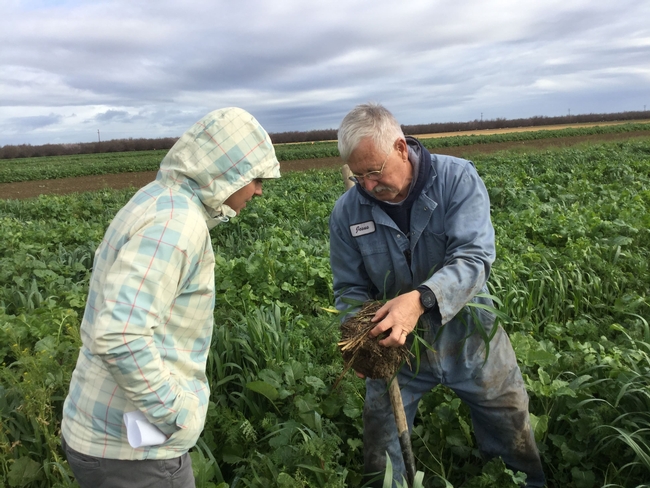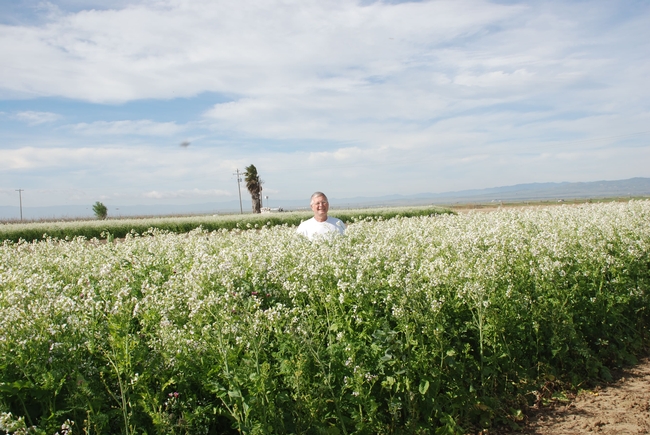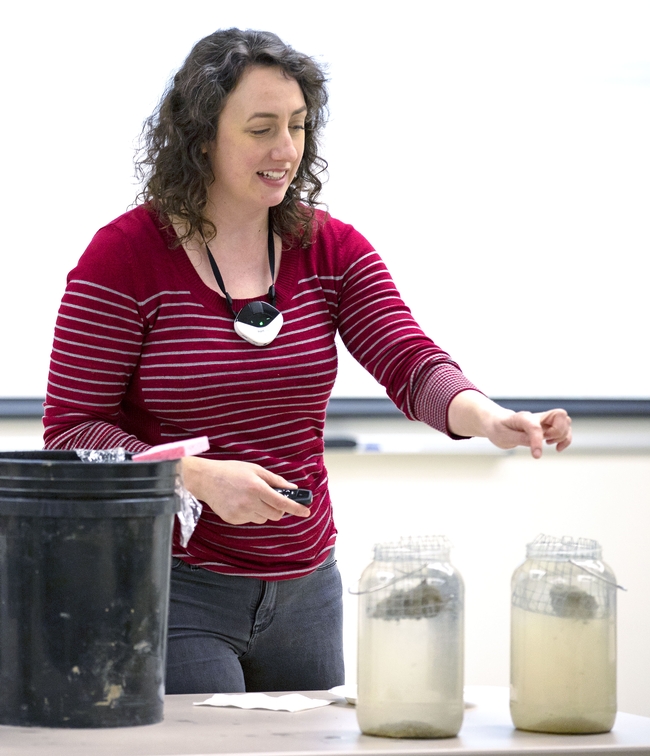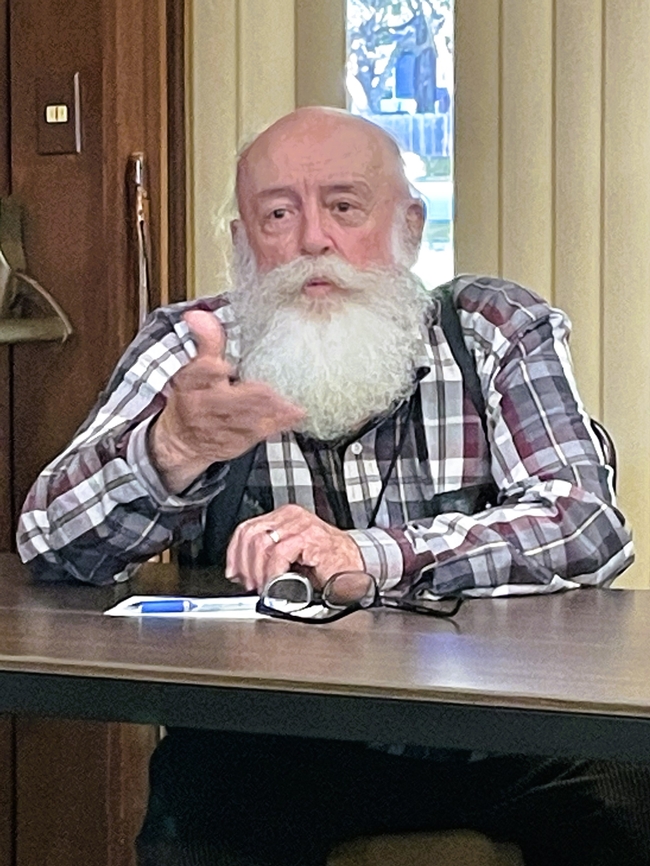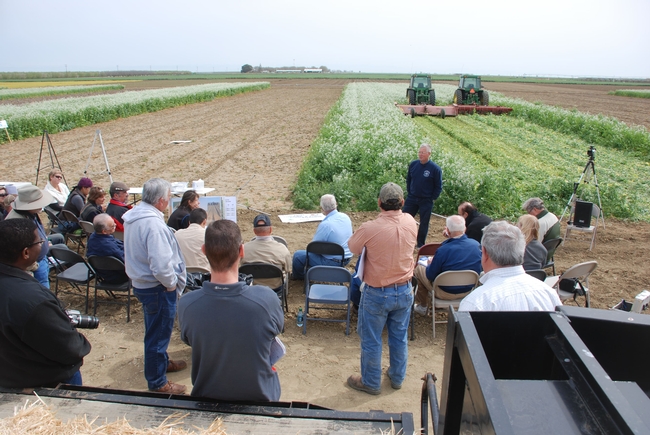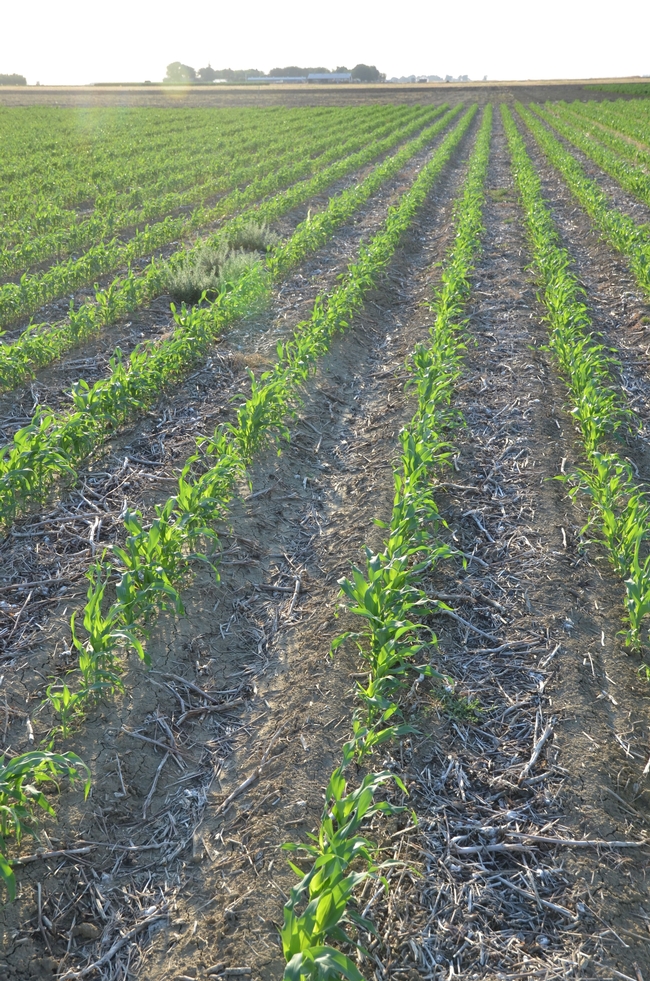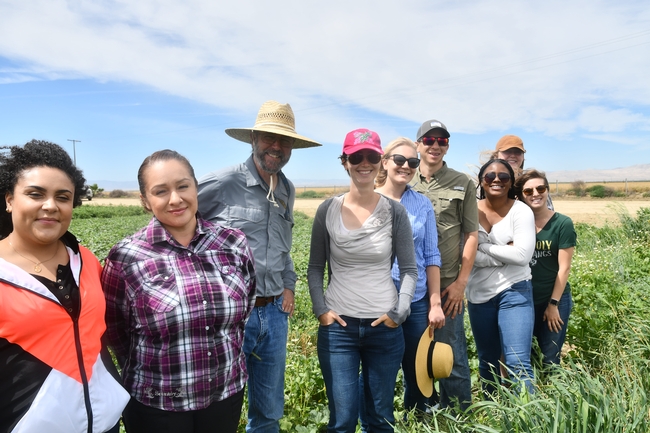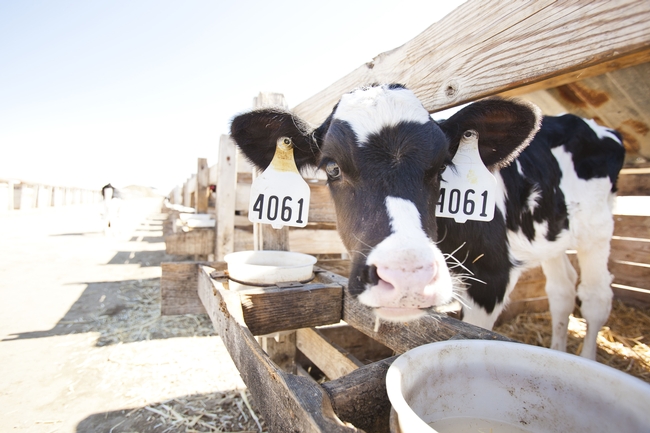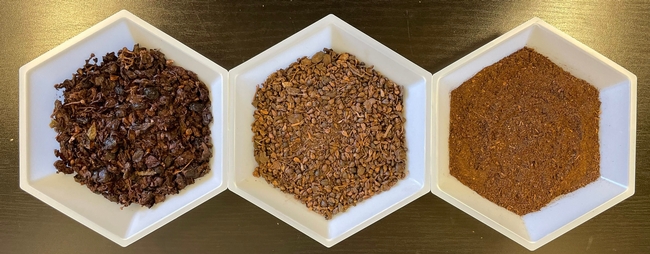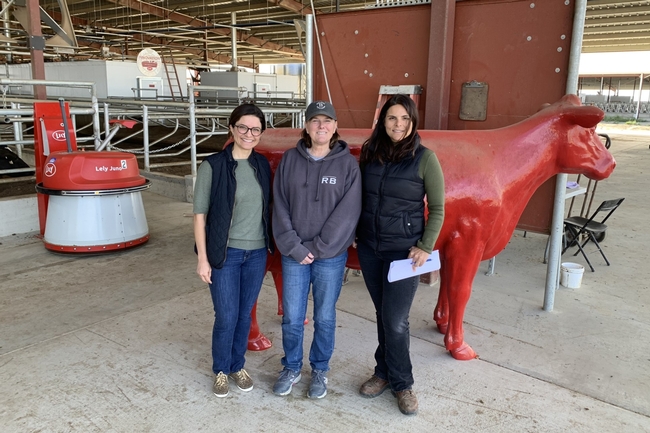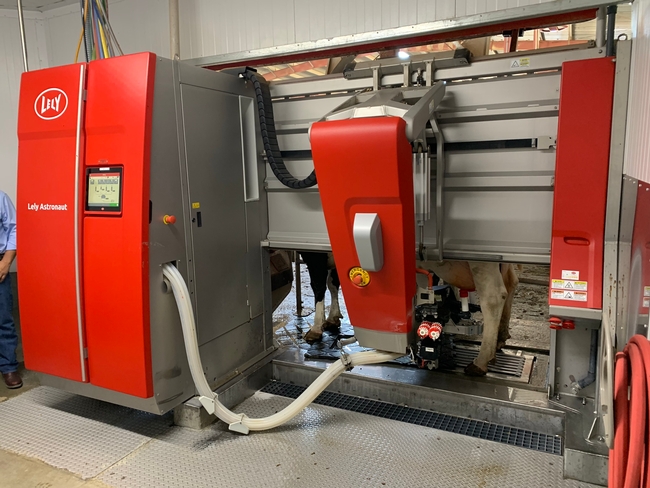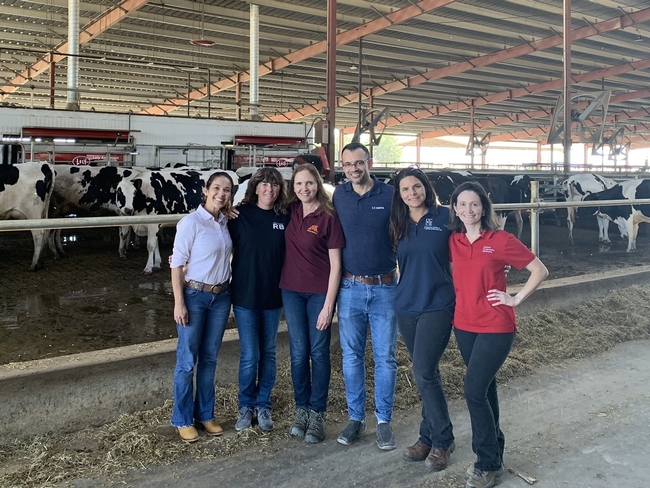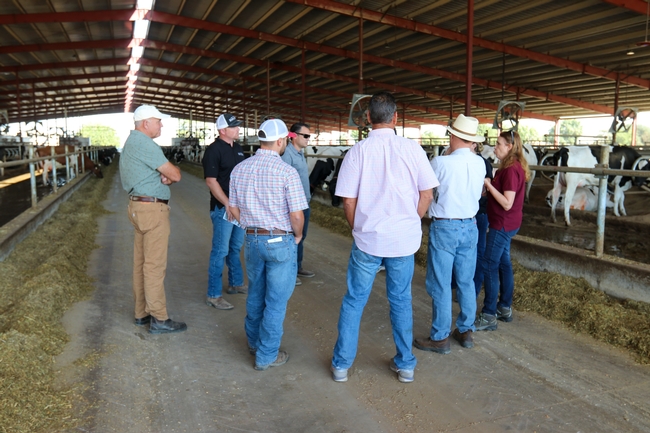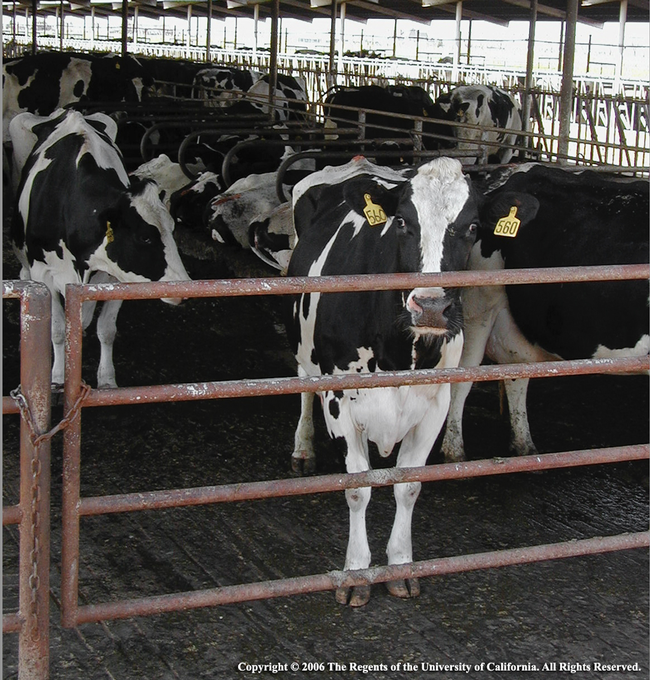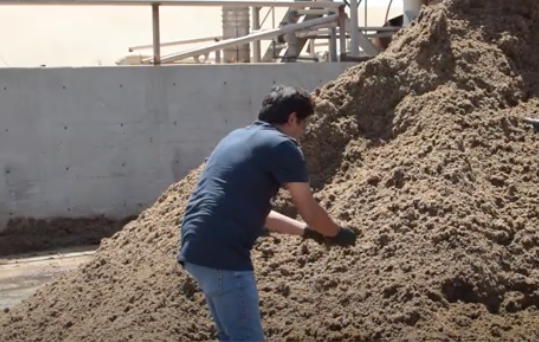Posts Tagged: dairy
West Side REC study: A cradle of California regenerative agriculture
In 20-year study, UCCE specialist Mitchell, colleagues, growers advance no-till and cover cropping practices
In the 1990s, long before “regenerative agriculture” was a buzzword and “soil health” became a cause célèbre, a young graduate student named Jeff Mitchell first learned about similar concepts during an agronomy meeting in the Deep South.
Mitchell was astonished to hear a long list of benefits attributed to practices known internationally as “conservation agriculture” – eliminating or reducing tillage, cover cropping and preserving surface residues (the plant debris left after harvest). Potential positive impacts include decreasing dust in the air, saving farmers money on fuel and equipment maintenance, improving soil vitality and water dynamics and a host of other ecosystem services.
“All of these things start adding up and you kind of scratch your head and say, ‘Well, maybe we ought to try some of this,'” recalled Mitchell, who became a University of California Cooperative Extension cropping systems specialist at UC Davis in 1994.
In 1998, Mitchell launched a long-term study of those practices at the West Side Research and Extension Center (REC) in Five Points, Fresno County. “We started this because, way back when I first began my job, nobody was doing this,” he explained. “This was brand-new, uncharted territory for California.”
For the next 20 years, Mitchell and his colleagues studied changes to the soil and ecosystem, learned from their failures and successes, and shared those hard-won lessons with fellow scientists and farmers across the state. A summary of their findings was recently published in the journal California Agriculture.
Conservation agriculture in California: ‘No trivial undertaking'
Mitchell and the Conservation Agriculture Systems Innovation Workgroup – a network established in 1998 comprising farmers, researchers, public agency personnel and members of private entities and environmental groups – started with a virtually blank slate. According to Mitchell, surveys at the beginning of the 21st century found that conservation agriculture practices were used on less than one-half of 1% of annual crop acreage in California.
Although no-till is common in the Midwest and Southeast of the U.S. and across wide swaths of the globe, it was almost unheard of in the Golden State. With the development of irrigation infrastructure in the 1920s, California farmers saw continually phenomenal growth in yield over the last century – and thus had little incentive to deviate from tried-and-true methods that relied on regular tillage.
Nevertheless, intrigued by the potential benefits of conservation agriculture, Mitchell wanted to see which of those practices could be feasibly applied to California cropping systems. During the 20-year study at West Side REC, the researchers grew a rotation of cotton-tomato, followed by a rotation of garbanzo, melons, and sorghum, and finally tomatoes.
But at first, it was a struggle to grow anything at all – as they had to master the basics of how to establish the plants in a no-till, high-residue system.
“This was no trivial undertaking,” Mitchell said. “Early on we struggled – we failed the first couple of years because we didn't know the planting techniques and we had to learn those. There was an upfront, very steep learning curve that we had to manage and overcome.”
Then there was the long wait to see any measurable improvements to soil health indicators, such as the amount carbon in the soil.
“For the first eight years, we didn't see any changes whatsoever,” Mitchell said. “But then they became strikingly different, between the no-till cover crop system and the conventional field without cover crops, and the divergence between those two systems became even starker.”
The two-decade time horizon for the West Side REC study is one major reason why it has been so valuable for growers and scientists alike.
“It's so hard to capture measurable changes in soil health and soil function metrics through research because those changes are really slow,” said Sarah Light, UCCE agronomy farm advisor for Sutter, Yuba and Colusa counties and a co-author of the recent California Agriculture paper. “Often in the course of a three-year grant you don't actually get statistically significant differences.”
Reaching, teaching and learning from farmers
The study site on the west side of the San Joaquin Valley also has been a vital teaching resource. Even though Light works with farmers in the Sacramento Valley, she has conveyed findings from that research with her clientele and uses soil samples from the site to vividly illustrate a significant benefit of conservation agriculture practices.
In one demonstration, she drops soil aggregates – which look like clumps of soil – into two containers of water. One clump, from heavily tilled land, falls apart quickly and the water becomes dark and murky. The other, comprised of soil that has been no-till and cover cropped for 20 years, holds together – a sign of healthy, resilient soil – and the water remains relatively clear.
“It's a really simple demo, but it's very effective because it shows how easily soil aggregates break apart with water – or not,” Light said.
That aggregate stability is a key factor in soil's ability to both move water (infiltration) and hold onto water (retention). Those dynamics are crucial for farmers to avoid ponding in their fields, preserve water for drier months, and generally endure the flood/drought whiplash of climate change.
Over the years, Mitchell has hosted thousands of visitors at the West Side REC study site to showcase the potential benefits of adopting soil-health management practices.
“I don't think I'm exaggerating in saying that this is probably the most-visited agricultural field station project in the history of UC ANR (UC Agriculture and Natural Resources),” he said.
Both the West Side REC – and Mitchell himself – are greatly valued by the local grower community.
“Jeff is a microcosm of the university's applied research on the West Side of the San Joaquin Valley,” said John Diener, who grows almonds, fresh market garlic, canning tomatoes, cotton, masa corn and wheat for production and seed on land adjacent to the field station.
Growers adopt, adapt and adjust practices
Tom Willey, a retired farmer and longtime collaborator with Mitchell, has actively encouraged peers to visit the Five Points site – especially in the early years.
“It was very innovative and there weren't many examples of that anywhere in the state,” Willey said. “So, I helped encourage people to go out there and learn and possibly think about doing similar work on their own farms.”
Willey himself was a pioneer in experimenting with no-till practices in organic vegetable cropping systems.
“As organic farmers, we were probably more tillage dependent than conventional farmers because it was the only method we had for weed control; we weren't able to use herbicides,” Willey said.
Despite early struggles, he persisted in trying different techniques and mechanical means of weeding. And Willey later partnered with a group of progressive vegetable growers and UC and California State University Chico personnel to secure a Conservation Innovation Grant from the Natural Resources Conservation Service to support more on-farm trials and share their experiences.
In the end, however, no-till proved too risky to continue, given the losses they incurred. One tricky issue is nutrient cycling. The organic growers found that after mowing down a cover crop and spreading compost, leaving those nutrients on the surface without incorporating into the soil through more vigorous tilling (or adding synthetic fertilizers, as conventional growers could do) results in lower yields. In the short term, farmers simply did not see yields that could sustain their operation.
“It's very difficult in vegetable systems, and particularly difficult in organic vegetable systems,” Willey said. “I would say a number of us have learned to diminish the over-reliance that we had on tillage, but not to completely eliminate it.”
Cover cropping is also a challenge for some farmers, with certain cover crops making a perfect haven for devastating pests such as lygus bugs and stink bugs, according to Diener.
“We do everything we can to eliminate the host crop from which they come, so why am I going to bring the enemies to my house?” he said. “It's about making enough money to be there next year. You're not going to be there next year with these pests. It's just not a practical management option, in light of our significant pest pressure and disease hosts for our crops of value.”
Instead of planting cover crops, Diener said he opts for mixing in grain crops that can similarly contribute to soil health – while generating revenue at the same time. According to Diener, a longtime collaborator with Mitchell, the best way to adopt conservation agriculture practices is to tailor them to specific localities and each grower's circumstances. And in his corner of the San Joaquin Valley, that means not following the template of the high-precipitation, no-till systems found in the Midwest.
“We've adapted Jeff's principles to our program; it won't look like Iowa to you, which is what everybody comes to expect to see. It ain't how it works, folks,” Diener said. “It's a different methodology. We do those things that fit our environment and that's why that West Side field station is important – because it's our environment.”
Promoting and enhancing soil health, one step at a time
More widespread adoption of soil-health management practices can be driven by a variety of factors. With the rise of drip irrigation in tomatoes, for example, more growers began using no-till or reduced till to minimize disruptions to the delicate driptape in their fields.
And, according to Mitchell, the dramatic increase in no-till practices in dairy silage production – from less than 1% to over 40% – was the result of entrepreneurial efforts by a small but extraordinarily dedicated group from the private sector that worked with farmers, one by one.
Because optimizing these practices requires close and intensive attention – and no small amount of courage and gumption – Mitchell and Light understand that growers might need to take an incremental approach. Even one fewer pass over the field, or cover cropping every other year, can provide some benefit for soil health, Light said.
“The value is that when you can prove the concept, then you can motivate every step of the way,” Light explained. “Jeff is showing the shining light of the goalposts, and that can motivate us to take every challenging step along the way.”
Shannon Cappellazzi, who helped with the data analysis on the recently published California Agriculture paper, agrees that there is value in taking a stepwise approach in building soil health.
Cappellazzi was the lead project scientist on the Soil Health Institute's North American Project to Evaluate Soil Health Measurements, which looked at 124 different long-term soil research sites across the continent – including the Five Points site.
After analyzing 2,000 samples from the various study sites, Cappellazzi said the evidence suggests that layering on each component of a conservation agriculture program – doing no-till, adding cover crops and then integrating livestock, for example – can have additive, cumulative benefits for soil health.
“I think having the data to show the long-term benefit makes people willing to do the short-term change, even if it's a little bit hard for a couple years,” Cappellazzi said.
The research at the West Side REC also produced another key takeaway.
“To me, what really stood out was that for most of the soil health indicators, cover crops had a huge impact. Both the cover crops that had no till – and the cover crops that had standard tillage – had considerably higher carbon and soil health indicator measurements than those without cover crops,” said Cappellazzi. She added that the data also indicated improvements in how the water moved into the soil, and how the soil held that water.
Vital research drives an enduring legacy
Water management and conservation, of course, will be paramount in California's increasingly volatile climate reality. Mitchell's Five Points research – and related studies across the San Joaquin Valley by UC Davis agroecologist Amélie Gaudin and others – contributed data that overturned a long-held belief about winter cover cropping.
“There's a lot of preconceived ideas about cover crop water use,” Mitchell said. “One of the things that we learned was that compared to bare soil water loss in the wintertime, cover crop water loss during that same growing period – from about November through March – tends to be almost a wash.”
That crucial finding provided researchers and soil health advocates with invaluable evidence to preserve the practice as an option for farmers.
“They've needed to go around and give a dog-and-pony show to a lot of Groundwater Sustainability Agencies (GSA) that had been on the brink of banning the growing of cover crops because the perception out there is that they use a lot of water,” said Willey, the retired vegetable grower. “But over the winter months, cover crops don't use a lot of water. In fact, they may not use any net water at all.”
The young researchers who studied cover-crop water use represent another important legacy of the Five Points study site. It has been an experiential training ground for many of the next generation of soil scientists, agronomists and ecologists.
“The number of students who have been trained by and through this study has been really phenomenal,” said Mitchell, noting that they have worked on topics ranging from air quality to soil carbon related to no-till and cover cropping.
Their contributions will be essential in continuing to refine and optimize these practices that are fundamental to conservation agriculture. On Diener's concerns about lygus bugs and stink bugs, for example, Cappellazzi – in her new role as director of research at GO Seed – is studying and breeding cover crops with an eye on characteristics that make for less hospitable habitats for certain pests.
Indeed, while the California Agriculture paper effectively wraps up the 20-year study at Five Points, its lessons will continue to resonate and inspire for years to come.
“This is a step in a long journey,” Light said. “It's a launchpad – this paper might be able to tie a bow on it in terms of the data collection, but in terms of the extension impact, this is really just the beginning.”
And for Willey, the omnipresent climate crisis compels the entire sector to pick up the pace along that journey.
“We've got a lot of pressure now to evolve agriculture very rapidly in response to climate change and I don't think we can sit around and twiddle our thumbs,” he said. “We know the directions we need to be heading – with more natural systems mimicry and less reliance on toxic inputs and synthetic fertilizers – and we need to figure out how to incentivize and support farmers in moving in those directions.”
Grape seeds, stems and skins can reduce dairy cattle emissions
Low-cost wine industry additive also improved feed efficiency and milk quality
Researchers at University of California, Davis, added fresh grape pomace left over from winemaking operations to alfalfa-based feed for dairy cows and found that methane emissions were reduced by 10% to 11%.
The preliminary findings could offer a low-cost sustainable pathway for vineyards to reduce waste while helping dairy operations maintain quality while cutting back on emissions of methane, which is a powerful greenhouse gas.
“This is the first time anybody has shown that this can work in California,” said Ermias Kebreab, an animal science professor and associate dean of global engagement at UC Davis. “You're reducing emissions, you're improving the quality and it may also reduce the cost of production.”
The pilot research project, which will be detailed in a paper later this year, also found that mixing in grape pomace improved feed efficiency and increased healthful fats, said Selina Wang, an associate professor of Cooperative Extension in small scale fruit and vegetable processing.
“We found that the feed with the additive of grape pomace changed the fatty acid composition of the milk and, in particular, increased the polyunsaturated fats, which are the main fats in grape pomace,” Wang said. “This suggests that supplementing the feed with an optimal fatty acid profile may have positive impact on the fatty acid profile of the milk and increase their health benefits.”
Symbiotic commodities?
In 2022, California was the leading dairy producer in the country, generating $10.40 billion in sales, while 90% of wine production came from the Golden State, with a market value of $5.54 billion.
Processing grapes for wine generates thousands of tons of waste in the form of grape pomace, which consists of leftover seeds, skins and stems. Dairy and livestock are responsible for more than half of the state's methane emissions, owed largely to cow burps.
They are the top two agricultural commodities in California, according to state production statistics, and reducing waste and emissions for both industries are key to the state meeting its climate goals.
Tannins for emission reductions
Wine grapes are high in fats and tannin, which is known to reduce methane emissions, so Kebreab sought to test if adding grape pomace to feed could have a positive effect while not adversely affecting production.
“It's a byproduct that's not being used much,” he said. “This is something that can be included in our efforts to try to reduce emissions.”
A mix of feed options
To do the research, scientists worked with Holstein dairy cows and gave the animals feed consisting of alfalfa, wheat, almond hulls, cottonseed and grain. After two weeks, the cows were split into three groups: A control group with no change in diet, another where the feed combination included 10% grape pomace and a third that received 15% grape pomace.
Every four weeks, the cow groups would change feed combinations.
They were fed twice daily by postdoctoral students and interns, and emissions were monitored daily. Milk production was documented in the morning and evening and milk samples were collected weekly to analyze for fat, protein, lactose and other measurements, which showed no differences between the control and other groups.
Methane and hydrogen emissions were reduced compared with the control group, suggesting that grape pomace reduced enteric emissions without affecting production.
“I think the dairy industry will be very interested in this,” Kebreab said. “Sometimes when you're using additives, they have palatability issues. With grape pomace, they absolutely love it.”
Next on the list is a trial with olive pomace and working to understand the mechanism that reduces emissions. “If we have a better understanding of the mechanisms, we can select the feed additive or a mix of feed additives to reduce dairy cattle emissions and make dairy milk healthier while making use of the agriculture byproducts,” Wang said. “There's a lot of room to grow in this space and we're excited about this work.”
The research was supported by the California Dairy Research Foundation.
This article was first published on the UC Davis news site.
UCCE advisor Bruno guides, learns from dairies switching to milking robots
Automatic milking systems increasingly used in California amid labor challenges
When third-generation dairy farmer Shonda Reid first saw a milking robot at a farm show 13 years ago, she immediately recognized that the technology represented the future. Her father, however, took a bit more convincing.
“I came home and showed him and said, ‘This is what we need to do.' And he thought I was kidding!” said Reid, dairy and farm manager for Fred Rau Dairy, which has a herd of 1,400 milk cows in Fresno County.
Years later, after the family had visited several dairies using automatic milking systems (AMS) across the U.S., they installed their first six robots in November 2021. By fall 2022, they had 24 robots, evenly split between two newly built “free stall” barns where the cows can freely go to the milking machines.
As Fred Rau Dairy was one of the first in California to implement AMS at such a scale, Reid and her team have been instrumental in growing practical knowledge on these systems. She also has been a valued partner to Daniela Bruno, University of California Cooperative Extension dairy advisor for Fresno, Madera and Kings counties.
“Automatic milking robots are not a new technology, but it's new to California,” said Bruno, noting that the milking robots were first used on small, family-run farms in Europe, where the technology granted family members more time for rest and other pursuits.
To better understand the feasibility of milking robots for large dairies in California, Bruno – alongside former UC Davis School of Veterinary Medicine professor Fernanda Ferreira, University of Minnesota researcher Marcia Endres and other collaborators – began a project in 2020 to study the risks and opportunities of automated systems.
“The information is extremely useful for California producers to make informed decisions about implementing AMS on their facilities,” said Denise Mullinax, executive director of the California Dairy Research Foundation, which supported the effort through a competitive grant. “Cow care, labor requirements and profitability are key issues for producers, and CDRF was pleased to support this project which assists producers in understanding how AMS may impact those areas on their facility.”
Dairy farmer: ‘We needed to make some changes'
The project produced a paper analyzing existing research on automatic systems, which have been more widely used in the Midwest, where there are more small-scale, family-run dairies. In 2020, there were only 14 “box robots” in California, according to Bruno. Now there are about 200 across California – and both Bruno and Reid cited labor challenges as the primary reason for the increased use of automated systems.
“California suffers from labor quality and quantity issues,” Bruno said. “By bringing robots to California, you can minimize those problems.”
Higher costs of hiring and retaining employees, driven in part by new labor laws, are one factor. And then there's the reliability and availability of labor, as fewer people are willing to do the physically demanding work of conventional milking.
“People just don't want to milk in a flat barn [a conventional setup where the employee works at the same level as the cow] – there's a lot of kneeling, squatting, that type of thing – it's pretty tough on the body,” Reid explained.
Faced with labor shortages and mounting regulatory burdens, Reid said Fred Rau Dairy had to make the leap to automated systems to keep the 80-year-old dairy operation running.
“We needed to make some changes, or we're going out of the dairy business,” she said.
In a survey conducted by Bruno and her colleagues of large dairies using AMS across the U.S., a majority of the 29 respondents reported reductions in labor costs – but survey results did not offer a definitive picture on whether AMS improved bottom-line profitability.
Calmer, healthier cows
Nevertheless, most of the survey respondents said they were generally happy with their transition to automatic systems.
“It's totally met our expectations, and cow health has gotten much better, too,” Reid said.
In a typical conventional system where cows are outside in “open corral” pens, dairy employees must cajole the cows into the milking parlor. But within a “free stall” barn where the cows can voluntarily go to the milking robots when they want, as often as they want, the animals are much less stressed.
“When you think about cow handling, if you have robots, you don't have anybody pushing and screaming at them to walk to the parlor,” Bruno explained. “You have less cow-people interaction so they are more calm; there is less stress.”
In the survey of large dairies using milking robots, more than 90% of the respondents said their cows were calmer. Reid also noted that many people have noticed how calm their cows are in the free stall barns.
“They're not skittish, you can walk in and they don't run,” Reid said. “They'll just watch you or they'll even come up and start licking on your jacket or shirt.”
Bruno also said that many of the large dairies reported fewer cases of mastitis and other diseases, less lameness, and greater milk production. But she added it's hard to know whether the benefits can be attributed to the robots and their real-time monitoring technology – or to changes in the physical environment (cows save energy in the free stall barn setup, versus the open-corral system that requires walking to the milking parlor).
Dairy producers seek counsel on potential transition
Less bovine travel from outside to inside was a boon for Fred Rau Dairy during last year's unusually wet winter.
“Even if it's just a couple of weeks of rain, that mud and manure and everything – you do what you can, but oh my gosh – it's a mess,” said Reid, noting that easier facility maintenance during extreme weather was another benefit of switching to automatic systems within free stall barns.
Reid shared many of her experiences with attendees of an AMS Field Day in October 2022, arranged by Bruno, Ferreira and their collaborators. About 60 farmers, researchers, industry representatives and consultants visited Fred Rau Dairy and Jones Dairy in Merced County.
If a dairy producer is considering implementing automatic systems, Reid recommends that they research all their options, visit dairies that use the systems, and check who in their area would be providing service and technical support.
And there are crucial workforce considerations, as dairy workers must learn an entirely new set of skills and processes. Instead of spending their time fetching the cows, prepping them and milking them in the parlor, workers might need to gather and interpret data from the robots. “Cow people,” as Reid puts it, must become computer people.
“You have a group of people who have been with you for a while, and you hope that they can transition to the new technology of what you're doing,” Reid said.
During this technological transition, and on the myriad other challenges that dairy operators face, Reid said she is grateful for Bruno's expertise and responsiveness.
“If there's something that I need, she's been really good about trying to help – or putting me in contact with the right people,” she explained. “I've enjoyed working with her.”
The AMS project team also includes UC Davis School of Veterinary Medicine professor Fabio Lima, postdoctoral researcher Thaisa Marques and former postdoctoral researcher Camila Lage.
California dairy farmers generate renewable energy from waste
California ranks number one in the nation for dairy production, with 1,100 to 1,200 dairy farms, each with an average of 1,436 cows, mostly concentrated in Tulare County in the San Joaquin Valley. A major dairy waste is cow manure, a byproduct that can require millions of dollars for each dairy to manage.
To help manage the manure, the California Department of Food and Agriculture provides funds to California dairy farms to install dairy digesters, a technology that can break down manure and produce methane (a form of renewable energy). The digesters provide additional benefits such as capturing greenhouse gases while improving the nutrient value of manure and water quality.
Pramod Pandey, UC Cooperative Extension specialist in the School of Veterinary Medicine Extension at UC Davis, has been studying dairy digesters for over 20 years to understand the conversion of manure into renewable energy. He also is trying to determine the effects of anaerobic processes (in low-oxygen conditions) on dairy manure quality, biogas production and the environment.
Between 2015 and 2022, CDFA supported approximately 133 dairy digester projects in California, with grants of more than $200 million to various dairy farms.
“The California state government plays a big role in the success of this technology because the majority of dairy farmers are not financially able to invest in implementing the manure management technology, which assist both dairy farms and community,” said Pandey.
For dietary components that cannot be completely digested by a cow's stomach, dairy digesters use a variety of bacteria to break down the manure under anaerobic conditions. This provides an option for sustainable waste treatment. The process not only reduces greenhouse gas emissions by capturing the gases released from manure, but also produces renewable energy in the form of biogas, which can be used as an alternative fuel for cars to further bring down greenhouse gas emissions. In addition, the dairy digester helps reduce odor and pathogens that pose a risk to human health.
According to Pandey, one cow can theoretically produce roughly 100 pounds of wet manure daily, and this manure contains nitrogen and phosphorous, which are important for soil. About 40 cubic feet of biogas is produced from the manure of one cow under anaerobic conditions, and this biogas has a potential to produce around 24,000 btu per cow. In California, a 1,000-square foot home uses 45,000 to 55.000 btu per day for heating and cooling. That means manure from two or three cows could meet the daily energy demand of a small home.
By using digesters, farmers can prevent greenhouse gas emissions and simultaneously generate energy and soil amendments, which provide nutrients to cropland, lessening the amount of commercial fertilizer needed. By connecting technologies, the liquid from digesters can be improved to produce water that can be used for irrigation and for meeting the water demands of a dairy farm.
“The main purpose of a dairy farm is to produce milk, and current low milk prices make it difficult for dairy farmers to focus on manure management without the support from government,” Pandey said, adding that managing waste is not only expensive but time-consuming. Although dairy digesters can cost $5 million to $10 million to build and install, the technology is helpful in manure management.
Dairy farmers traditionally use anaerobic or manure lagoons to store their liquid manure waste until they are ready to apply it to farmland as fertilizer. The issue is that the lagoons emit greenhouse gases such as methane into the atmosphere.
“It is important to not overexpect from a dairy digester because it doesn't reduce all forms of pollution from manure completely,” Pandey said. “But given the available resources, funding and technology, I would say that we're off to a good start.”
Dennis Da Silva, a dairy farmer in Escalon, has been working in the industry his entire life and used to be “totally against” digesters. In the late 1970s, Da Silva's father, who immigrated from Portugal, started Da Silva Dairy Farm, which Da Silva currently runs.
“I spend a lot of money getting solids out of my lagoons every year,” Da Silva said.
Although he does not have digesters set up on his farm just yet, Da Silva agreed with Pandey that the government has made it much easier for farmers like himself to tackle waste.
“I used to be against the dairy digester idea, but there's a lot more incentive to invest these days,” said Da Silva. “It's also likely that, in the future, there'll be regulations that will crack down on dairy farms if you don't already have digesters,” he added.
Currently, he is in the permitting phase, waiting for approval to begin building the digester on his farm, which is expected to take about two years.
Pandey said that the process is slow and there is still a lot of room for improvement, but the intention is a step in the right direction. “The only thing that the digester doesn't produce is milk,” Pandey said jokingly.
RELATED LINK
VetMed Extension Spotlight on Pramod Pandey https://youtu.be/qKcGMcT8-UI.
Climate-Change Resources
University of California UC ANR Green Blog (Climate Change and Other Topics) https://ucanr.edu/blogs/Green/index.cfm?tagname=climate%20change (full index)
Examples:
- Save Trees First: Tips to Keep Them Alive Under Drought https://ucanr.edu/b/~CdD
- Landscaping with Fire Exposure in Mind: https://ucanr.edu/b/~G4D
- Cities in California Inland Areas Must Make Street Tree Changes to adapt to Future Climate https://ucanr.edu/b/~oF7
Drought, Climate Change and California Water Management Ted Grantham, UC Cooperative Extension specialist (23 minutes) https://youtu.be/dlimj75Wn9Q
Climate Variability and Change: Trends and Impacts on CA Agriculture Tapan Pathak, UC Cooperative Extension specialist (24 minutes) https://youtu.be/bIHI0yqqQJc
California Institute for Water Resources (links to blogs, talks, podcasts, water experts, etc.) https://ciwr.ucanr.edu/California_Drought_Expertise/
UC ANR Wildfire Resources (publications, videos, etc.) https://ucanr.edu/News/For_the_media/Press_kits/Wildfire/ (main website)
-UC ANR Fire Resources and Information https://ucanr.edu/sites/fire/ (main website)
-Preparing Home Landscaping https://ucanr.edu/sites/fire/Prepare/Landscaping/
UC ANR Free Publications https://anrcatalog.ucanr.edu/ (main website)
- Benefits of Plants to Humans and Urban Ecosystems: https://anrcatalog.ucanr.edu/pdf/8726.pdf
-Keeping Plants Alive Under Drought and Water Restrictions (English version) https://anrcatalog.ucanr.edu/pdf/8553.pdf
(Spanish version) https://anrcatalog.ucanr.edu/pdf/8628.pdf
- Use of Graywater in Urban Landscapes https://anrcatalog.ucanr.edu/pdf/8536.pdf
- Sustainable Landscaping in California https://anrcatalog.ucanr.edu/pdf/8504.pdf
Other (Non-UC) Climate Change Resources
Urban Forests and Climate Change. Urban forests play an important role in climate change mitigation and adaptation. Active stewardship of a community's forestry assets can strengthen local resilience to climate change while creating more sustainable and desirable places to live. https://www.fs.usda.gov/ccrc/topics/urban-forests
Examining the Viability of Planting Trees to Mitigate Climate Change (plausible at the forest level) https://climate.nasa.gov/news/2927/examining-the-viability-of-planting-trees-to-help-mitigate-climate-change/
Reports and other information resources coordinated under the auspices of the United Nations and produced through the collaboration of thousands of international scientists to provide a clear and up to date view of the current state of scientific knowledge relevant to climate change. United Nations Climate Action
Scientific reports, programs, action movements and events related to climate change. National Center for Atmospheric Research (National Science Foundation)
Find useful reports, program information and other documents resulting from federally funded research and development into the behavior of the atmosphere and related physical, biological and social systems. Search and find climate data from prehistory through to an hour ago in the world's largest climate data archive. (Formerly the "Climatic Data Center") National Centers for Environmental Information (NOAA)
Think tank providing information, analysis, policy and solution development for addressing climate change and energy issues (formerly known as the: "Pew Center on Global Climate Change"). Center for Climate & Energy Solutions (C2ES)
Mapping Resilience: A Blueprint for Thriving in the Face of Climate Disaster. The Climate Adaptation Knowledge Exchange (CAKE) was launched in July 2010 and is managed by EcoAdapt, a non-profit with a singular mission: to create a robust future in the face of climate change by bringing together diverse players to reshape planning and management in response to rapid climate change. https://www.cakex.org/documents/mapping-resilience-blueprint-thriving-face-climate-disaster
Cal-Adapt provides a way to explore peer-reviewed data that portrays how climate change might affect California at the state and local level. We make this data available through downloads, visualizations, and the Cal-Adapt API for your research, outreach, and adaptation planning needs. Cal-Adapt is a collaboration between state agency funding programs, university and private sector researchers https://cal-adapt.org/
Find reports, maps, data and other resources produced through a confederation of the research arms of 13 Federal departments and agencies that carry out research and develop and maintain capabilities that support the Nation's response to global change. Global Change (U.S. Global Change Research Program)
The Pacific Institute is a global water think tank that combines science-based thought leadership with active outreach to influence local, national, and international efforts to develop sustainable water policies. https://pacinst.org/our-approach/
Making equity real in climate adaptation and community resilience policies and programs: a guidebook. https://greenlining.org/publications/2019/making-equity-real-in-climate-adaption-and-community-resilience-policies-and-programs-a-guidebook/
Quarterly CA Climate Updates and CA Drought Monitor Maps (updated each Thursday) https://www.drought.gov/documents/quarterly-climate-impacts-and-outlook-western-region-june-2022

